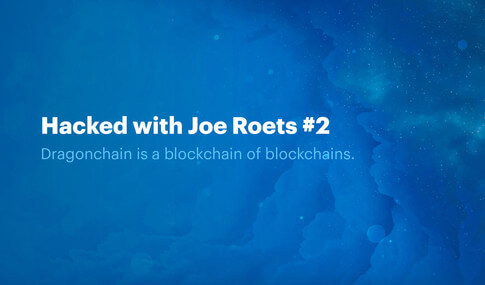The blockchain of blockchains - Hacked with Joe Roets 2
[Paul]
Eos has it’s own blockchain. Dragonchain uses the Ethereum network.
[Brian]
Dragonchain is a blockchain of blockchains. Their architecture may be best understood as a “blockchain of blockchains”. That is, a business approval function node (see Level 1 below) functions much as a standard blockchain on a 1 dimensional level. However, each business concern will generally have its own node to do this work, each with its own blockchain. It is where these blockchains become combined that consensus is reached.
[Paul]
The thing is if you have your own blockchain and you use POW for example, you need as much hashpower as you can get with at least 51% of the nodes being honest. So adoption of the token/network is critical and a rising token price helps with that. For me it’s unclear where Drgn stands in this. It looks like they delegate this problem to other blockchains. Level 5 Public checkpoint clearly shows delegation to another public chain. But Level 4 Notary is some third party (centralized) node or a group of (trusted centralized) nodes
Level 1-3 seem to do some verification as well, but I can’t see which blockchain network is doing the verification. Are those Dragonchain nodes? If so are those centralized? In short if you have your own blockchain, ur guaranteed that more adoption leads to more demand of your token and as a result higher token price. But if you have a different type of architecture I’m not so sure.
[Brian]
Dragon net uses TIME to provide Consensus and prevent a 51% attack L2-4(not the actual token that generates TIME)......Public wrapping @L5 TX over multiple chains with a 51% attack would be something fantastic(in a bad way) to see for sure. L2-4 is community provisioned. For L4 I'll let Joe Roets explain the process for even running one of these as I'm not totally aware of the full requirements and address your centralized concerns of that particular level as I'm not sure this has been finalized either
[Joe Roets]
What is this? A substantive technology discussion on the traders channel? Should we move to another channel? I don't want to distract from price FUD. 😂 (just kidding) I don't have time enough right now for a long answer, but...
- In Proof of Work (PoW), price doesn't affect security directly, but rather through incentives for mining adoption.
- In Proof of Stake (PoS), price directly affects the staking (though in many cases it's maybe too complex a model to work well?)
With Dragonchain, architecturally, we do allow any proof (PoW, PoS, trust, as yet undefined tech) to be applied to any of the many chains (L1-L5), but in practice, there are theoretical reasons for this that I won't go into here because we've only experimented with that capability at Disney and at Dragonchain, and it's never been a top priority because the architecture provides so many simpler answers to that need.
In practice, with the current implementation, all nodes from L1-L4 are trust based, and offer progressive decentralization of ownership. With upcoming releases, we will open source and then make possible the on-prem deployment of at least L2 & L3 nodes (and maybe all levels with some verifiable criteria [e.g. TIME])...
What Paul states above, yes, the point of L5 in the architecture is to delegate verification to public nodes. We began with BTC at Disney, expanded that to ETH, ETC, and NEO commercially, and have plans to add as many more as possible. It is _not_ however a simple delegation. Dragonchain automatically aggragates the combined security of__ALL__ Interchained public networks to a user's L1 business node. The purpose of this though is not just one of magnitude (of hashpower for example), but one of diversity.
That is, if we gather network verification from as many algorithms as possible (BTC + LTC + tangle + staking + quantum safe), we will have a radically robust network for final proof of any transaction on our platform, measurable from many angles.
So, for DragonNet itself (L2-L4) we use scarcity of time as the network verification basis (this is patented) - - which would require an attacker to either compromise many nodes/keys on the network and "re-weave" the links for a given L1 chain, — or — accumulate a large amount of DRGN and hold it for a significant time in order to gain enough access within the network for _every_ level in DragonNet.
This scarcity of TIME is wholly based upon the DRGN software license token as a utility. With L5, they would have to execute a 51% attack on _all_ L5 chains, each with its own defenses against such an attack. If such an attack were carried out (e.g. nation state or aliens) there would be evidence of the the attack in the form of synchronized forks across all referenced chains.
We've already seen proof of this in the ETC 51% attack that happened - - whether or not it was important to ETC, it did not affect Dragonchain at all as we were concurrently hitting BTC, ETH, and NEO for the same period. (none of the above considers the other - - some may consider more important - - utility of the public network delegation which is our Interchain technology (also patented) that allows the user to delegate part of their business process to other chains (e.g. ETH, ETC, NEO) for the purposes of explicit outward transparency or security). I hope that makes sense - - most of this is covered in depth in the architecture document.
